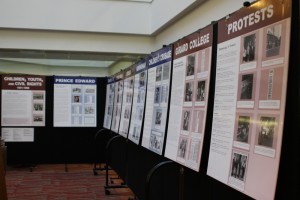The Hagerty Library currently features a traveling exhibit depicting the struggles of African-American youth during the civil rights movement. The exhibit, titled “Dean of Libraries Danuta Nitecki explained that Franklin reached out to his former colleague at Drexel, Julie Mostov, the vice provost for global initiatives, about Drexel hosting the display. Mostov then contacted Nitecki about displaying the exhibit in Hagerty.
“We don’t have the capacity [to show too much in the way of displays],” Nitecki said. She added, however, that she likes to bring in exhibits, especially decent traveling ones.

According to Nitecki, Drexel was approached about hosting the display at the end of April 2014, and she realized that it would be best to have the exhibit’s presence coincide with the University’s Martin Luther King Jr. Day celebrations. “We tried to identify various people and classes who might want to use it on campus,” she said. “We thought at first that we would do a program, but we don’t have the space [in the library], but we were delighted when our colleagues [were interested in holding a panel].”
“Our vision was to bring academics, community members, a theologian, activists and students together, who have diverse opinions and life experiences, to have a necessary discussion concerning history, race, police and politics in the United States,” Jacqueline Rios, communications and events coordinator for the Center for Interdisciplinary Programs, wrote in an email. “The goals of the event were to honor the legacy of the civil rights movement and Dr. Martin Luther King Jr., as well as to give perspective to the current Black Lives Matter movement and draw parallels and distinctions from the Civil Rights era. We wanted to provide attendees with information about the impetus of the Black Lives Matter movement, as well as shed light on why this movement is happening at the present time, as opposed to any other point in history after the civil rights movement.”
The event, “Civil Rights: From Mississippi Freedom to Ferguson,” was held Jan. 15, and a recording of the event is available online. One panelist was Donald Tibbs, associate professor at the Thomas R. Kline School of Law. “It was a very engaging panel that was expertly moderated by Dr. Tony Monteiro, [a W.E.B. DuBois Scholar],” he said. “The panel did a wonderful job of invigorating a discussion about race and injustice in America.”
During the question and answer session following the panel, an attendee asked Nayo Jones, a Philadelphia Youth Poetry Movement spoken word artist, to perform a piece. “She gladly accepted,” Rios wrote. Additionally, Etienne Maurice, a senior film and video major, led the crowd in singing “We Shall Overcome.”
“I am still beaming with pride with how positively received this event was,” Rios wrote.
“I hoped that people would engage the panel and understand what’s most important,” Tibbs said. “I hope the audience was willing to receive the criticisms and accolades about policing … the arts, and just society in general.” He added that he hoped attendees brought back to their friends and families what they had discussed.
Andre Carrington and Taylor Nicole Johnson also served as panelists at the event. Carrington is an assistant professor of English at Drexel. Johnson is a theologian and educator, as well as an activist involved in the Black Lives Matter movement.
The exhibit itself chronicles the role children and teenagers played in the civil rights movement. It also follows the unfair treatment of Latino students in California in 1968, who protested in “blowouts.” “The power of the exhibit is that it’s bringing together different stories,” said Nitecki. “We’re talking about Milwaukee, Chicago, New York as well as the Southern states.”
“We take for granted that a lot of people understand the struggles and the suffering that were tantamount to the civil rights movement,” Tibbs said. He noted that most accounts of the movement focus on the major individuals involved, although many minor players made sacrifices both small and large.
Young people contributed to the protests of their parents. “Interestingly, back then the law knew no limits in how we would treat African-Americans,” Tibbs explained when asked about these harsh punishments. He cited a quote from
“That ideology carried forward into the [time of the] civil rights movement, so age and gender didn’t matter in your treatment,” Tibbs continued.
Franklin currently works at the University of California on its Riverside campus. He holds a University of California President’s Chair and is a distinguished professor of history
The exhibit will be hosted on the first floor of Hagerty until Feb. 13. According to Nitecki, Franklin will come to Philadelphia to aid in the move to its next destination, and he may be involved in another program similar to the panel.

